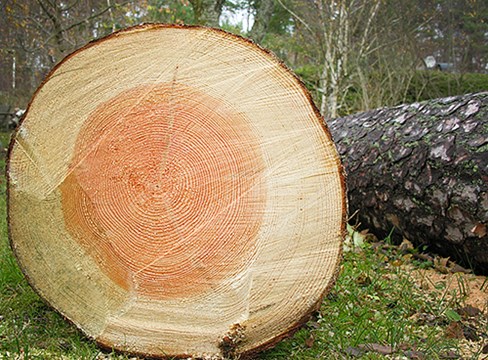Wood protection
Pictured: Pine cladding treated with linseed oil. Pumpkällehagen, Viskafors, nominated for the Swedish Timber Prize 2012.
Wood and wood products can be treated in various ways to change certain properties. There are methods to affect the wood’s durability, hardness, dimensional stability and moisture absorption. These methods can be divided up into:
- Treatment against fungal and insect attack
- Fire protection treatment
- Dimensional stabilisation
- Hardening
Treatment against fungal and insect attack
Wood protection usually refers to measures that in various ways aim to protect wood and wood-based materials against attacks by wood-decaying fungi, blue stain, mould, insects and marine pests (such as shipworm).
When building in wood, the structure should be designed to prevent such attacks, giving what is known as structural protection. The goal is for the wood not to have too high a moisture content for a prolonged period of time. Temporary damp should be able to quickly dry out and the moisture content should be able to return to normal levels.
There are situations where structural wood protection cannot be achieved and high moisture content levels are a permanent feature. In such cases, wood with better durability can be used. There are types of wood and parts of the tree trunk that offer better durability than others. There are also options for modifying wood to increase its durability. In addition, chemicals can be added to the wood to give greater durability. Find out more in the next section.
Treatment with chemical wood preservatives
Adding various chemicals to the wood can hinder or prevent attacks by organisms that damage wood. Different substances have different levels of effectiveness, but the quantity of added chemicals also determines the performance. The chemicals may be added manually via coating and dipping, or industrially using pressure treatment.
Coating and dipping give a surface effect. The substances don’t penetrate deeper into the wood. The effect is thus limited. These methods are therefore used as a complement, using penetrating priming oil on end-grain wood surfaces for example, to reduce moisture absorption in pressure treated wood.
Coating products are used primarily for the surface treatment of decking and outdoor furniture. New products are constantly being developed in order to create products with improved performance and no harmful impact on the environment.
Pressure treatment is used primarily on pine, where the sapwood has the capacity to absorb the impregnation agent while only superficial penetration is achieved in the heartwood. To give treated pine better durability, all the sapwood must be impregnated all the way to the heartwood. When pressure treating spruce, only a limited amount of the impregnation agent penetrates into the wood. Pressure treated spruce therefore has poorer protection than pressure treated pine.
A classification for pressure treated wood sold in the Nordic countries has been drawn up by the Nordic Wood Preservation Council (NTR), based on European standards for treated wood. The classification relates primarily to pressure treated pine, but now also includes industrially treated spruce.
In order to distinguish wood in wood preservation classes NTR/A and NTR/AB from each other at the point of sale and in construction (beyond relying on the label), the different wood preservation classes are treated in different dimensions. Sawn and planed wood with a thickness of up to 38 mm is treated in class NTR/AB. Wood up to 50 mm thick but with a width of up to 125 mm is also treated in this class. Other dimensions are treated in wood preservation class NTR/A. See table 24.
The majority of treated wood sold on the Nordic market is quality controlled, and labelled NTR. The controls are certified by a third party, and relate to the quality of the finished product, including chemicals used, absorbed quantities and full penetration, but also associated environmental issues. Treated wood that is not quality controlled to NTR standards can also be found on the market.
The technical properties of treated wood are largely the same as for equivalent untreated wood, for example in the context of appearance grading and strength grading. As a rule, metals corrode more quickly than treated wood. Metal fittings and fixings such as nails and screws should be rustproof – use stainless steel or hot dip galvanised steel.
Waste from treated wood should be handled in line with local authority instructions.
Guidance in choosing a chemical wood preservative
Wood protection is an important consideration when building anything in wood. The interplay between structural design, material choices and maintenance plays a crucial role in the structure’s function and service life.
When it comes to designing structures, the first point is, as far as possible, to avoid moisture traps where the wood is unable to easily dry out, creating a risk factor for future rot to set in. The range of available materials is growing all the time, so to make the choice of materials easier and enable you to specify wood protection that is fit for purpose, it is worth trying to answer the following questions:
- What are the requirements or wishes concerning the structure’s expected service life?
- Is the structure exposed to wind and weather, is it close to or in contact with the ground or water, is it impossible to avoid moisture traps?
- Is the structure easy to inspect for any damage?
- What consequences could an unexpected failure have, and is there a risk of personal injury?
- Are there any specific requirements or wishes concerning technical properties or interaction with other materials? Is the structure load-bearing? What is the situation regarding colour fastness? Can the wood be painted?
- What maintenance can be expected during the wood’s lifetime and is the structure easy to access for maintenance and repairs?
- How is waste handled (offcuts, scrap wood)? Could it be used to fire your own boiler, for example, or does it have to be taken to the local waste facility?
The expected service life, or technical lifetime, is important, and here aesthetic considerations must also be taken into account. The higher the standards required, the more important it is to take account of both the structural design and the material’s properties from a durability perspective and in terms of maintenance and aesthetics.
When assessing the risk of attack from wood-destroying organisms, there is always a risk to wooden structures in permanent contact with the ground or water. For structures above ground, there is a risk of rot that can be graded from almost negligible to essentially as great as in contact with the ground, and it is not always easy to determine the risk.
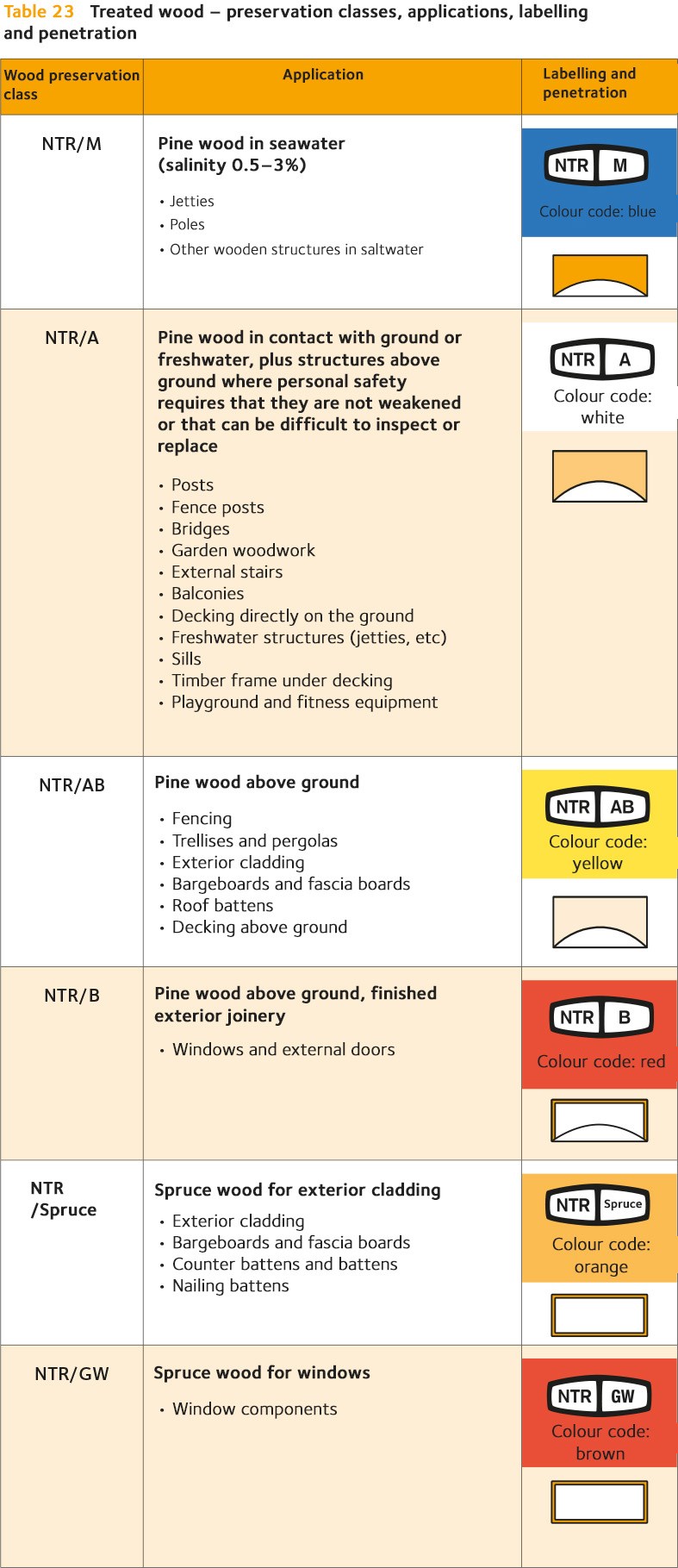
Find out more...
NTR Dokument nr 1:2013 Nordiska träskyddsklasser och produktkrav för impregnerat trä. Del 1: Furu och andra lätt impregnerbara barrträslag. Nordic Wood Preservation Council, 2012.
NTR Dokument nr 1:2011 Nordiska träskyddsklasser och produktkrav för impregnerat trä. Del 2: Gran. Nordic Wood Preservation Council, 2011.
NTR Dokument nr 3:2013 Nordiska regler för kvalitetskontroll av impregnerat trä. Del 1: Furu och andra lätt impregnerbara barrträslag. Nordic Wood Preservation Council, 2012.
NTR Dokument nr 3: 2011 Nordiska regler för kvalitetskontroll av impregnerat trä. Del 2: Gran. Nordic Wood Preservation Council, 2011.
NWPC Document no 2:2010 Conditions for approval of wood preservatives for industrial wood preservation in the Nordic countries. Part 1. Scots pine and other permeable softwoods. Nordic Wood Preservation Council, 2010.
SS-EN 335:2013 Durability of wood and wood-based products. Use classes: definitions, application to solid wood and wood-based products. SIS Förlag AB, 2013.
SS-EN 351-1:2007 Durability of wood and wood-based products. Preservative-treated solid wood. Part 1: Classification of preservative penetration and retention. SIS Förlag AB, 2007.
SS-EN 15228:2009 Structural timber. Structural timber preservative treated against biological attack. SIS Förlag AB, 2009.

Modified wood
The durability of wood can be improved through modification, for example heat treatment (thermal modification), furfurylation and acetylation.
Heat-treated wood
Heat treatment can be performed on both softwood and hardwood, and is conducted under oxygen-free conditions at temperatures of between 160°C and 220°C. The treatment causes changes in the wood’s chemical and physical composition. The wood takes on a brown colour that later turns to a grey shade on exposure outdoors. Heat-treated wood has lower moisture absorption and limited movement compared with untreated wood. Heat-treated wood is less strong and more brittle, and should therefore not be used in load-bearing structures.
There is no official quality system but there are two classes on the market, S (Stability) and D (Durability), where class S is wood with improved dimensional stability and class D is wood with improved durability.
Furfurylated and acetylated wood
Furfurylation, impregnation with furfuryl alcohol, and acetylation, impregnation with acetic anhydride, are currently only conducted abroad and availability is limited on the Swedish market.
Table 25 Heat-treated wood – applications
| Indoor class S (Stability) | Outdoor class D (Durability) |
|
|
Fireproofed wood
Wood that is impregnated or painted with a fire retardant can provide protection against fire.
Impregnation uses chemicals that inhibit combustion. These do not bind firmly in the wood, which therefore has to be protected with a painted coating.
Surface treatment with a fire retardant paint provides a coating that swells in the event of fire, extending the time until the wood ignites.
Dimensionally stabilised wood
Dimensional stabilising refers to methods aimed at reducing the shrinkage or swelling in wood. These methods are only used for specialist applications, such as wooden sculptures, to limit the amount of splitting. It is often a case of filling the structure of the wood with thermoset plastics to limit the absorption of moisture.
Hardened wood
The hardness of wood is specific to each wood species, and is strongly tied to the wood’s density. Pine and spruce have a relatively low hardness compared with oak, for example.
Wood can be made harder through compression, which increases the density. To make the compression last, the wood is impregnated with plastics that lock the compressed structure in place.
Hardened wood is used in flooring, for example.

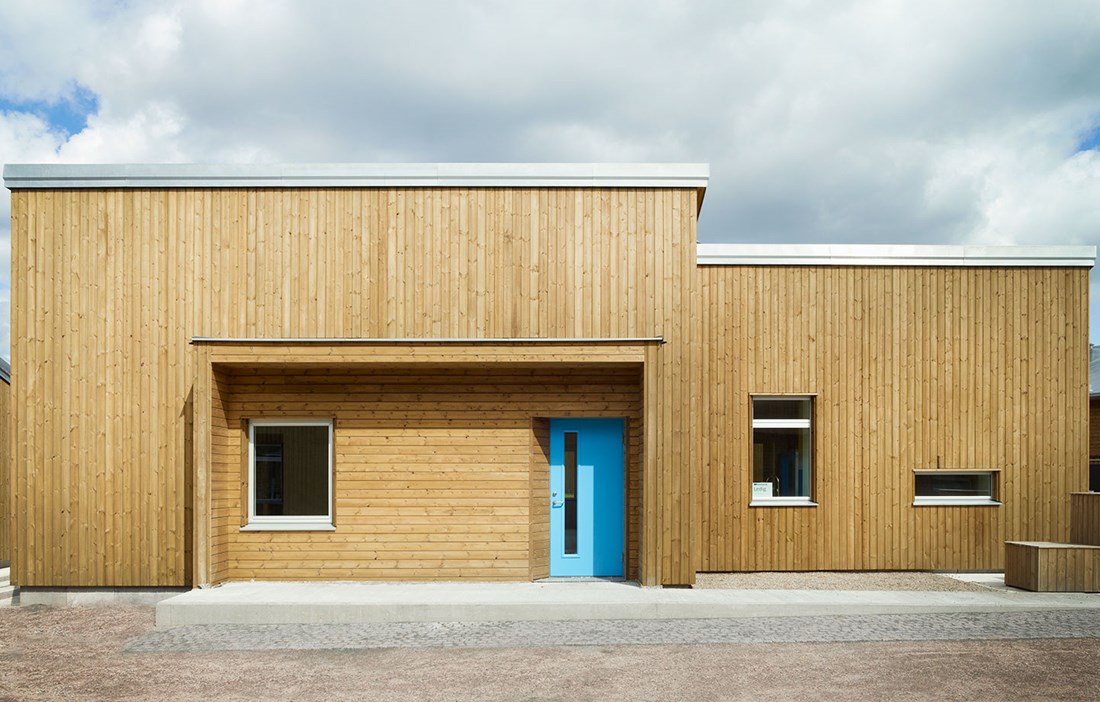
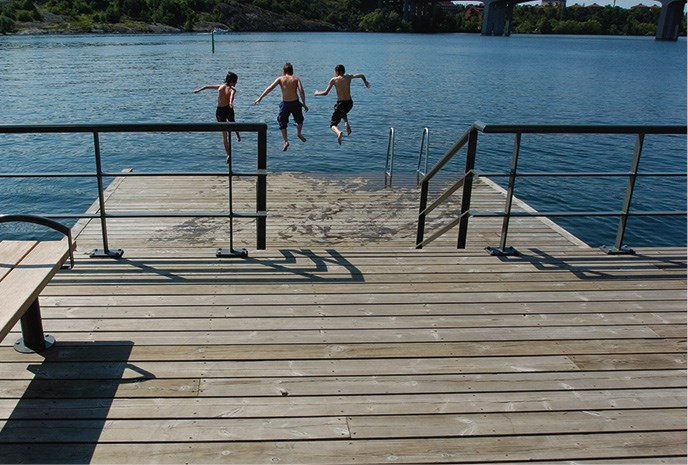 Pressure treated pine
Pressure treated pine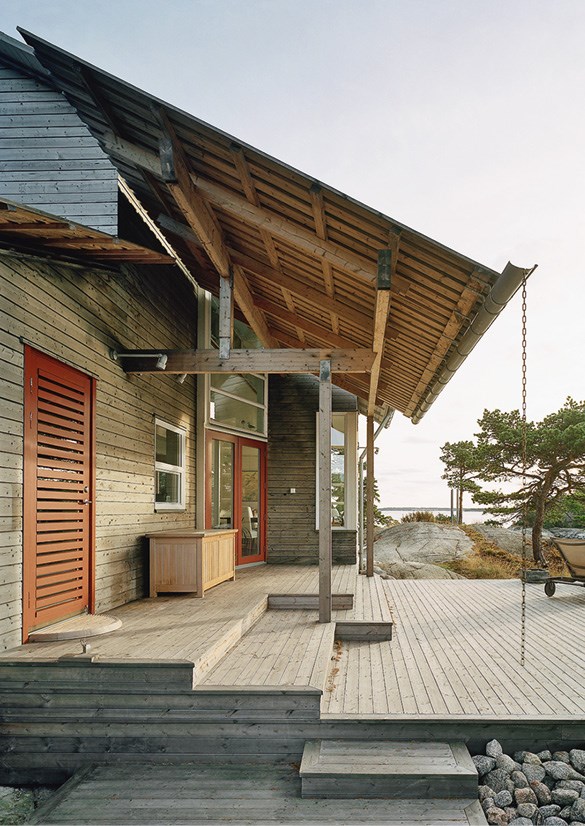
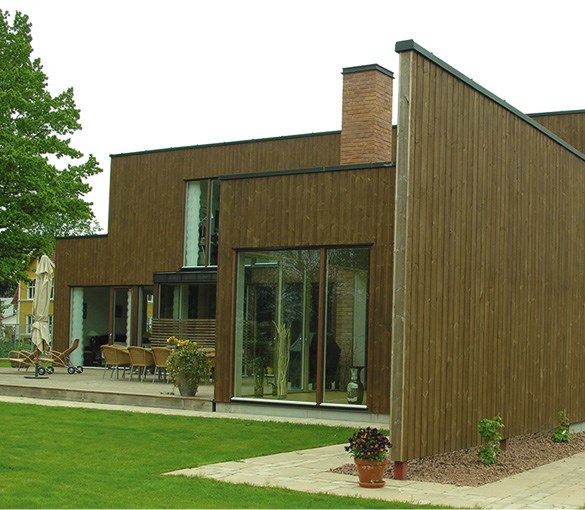
 Park area in pressure treated wood, Piteå.
Park area in pressure treated wood, Piteå.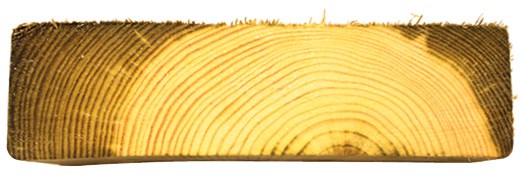
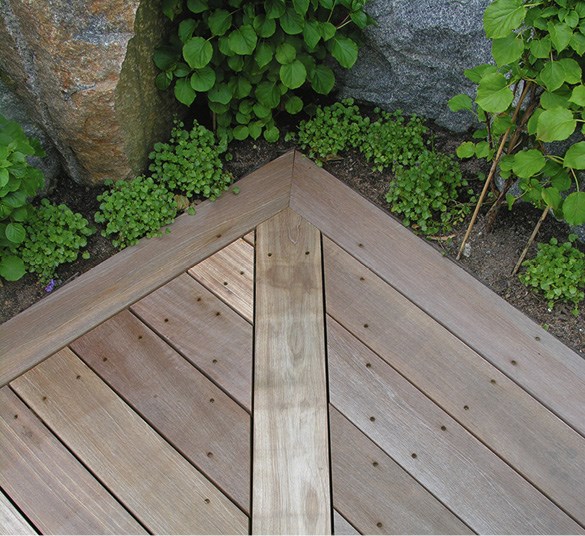 Design solution to conceal end-grain wood.
Design solution to conceal end-grain wood.

